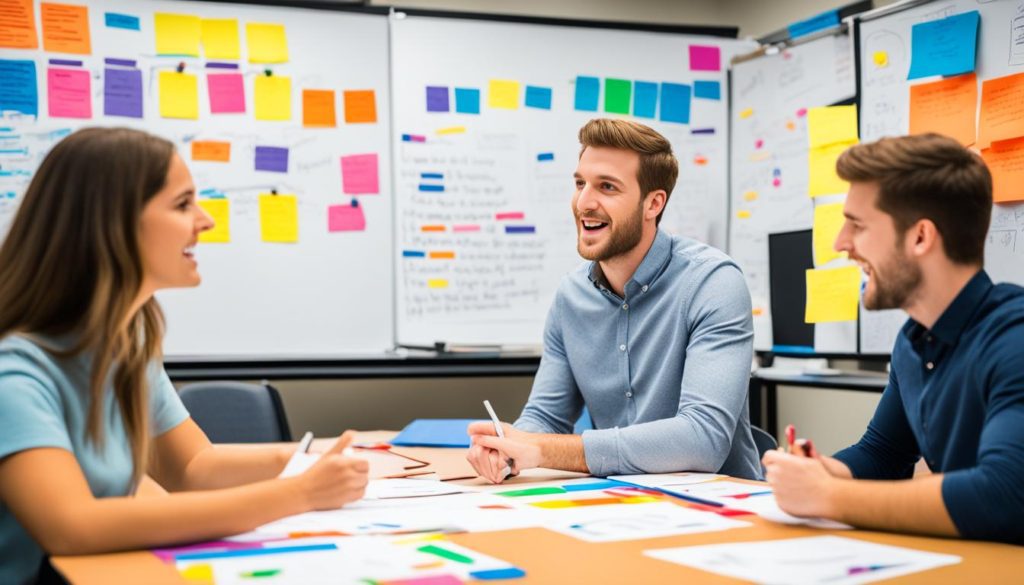In education, there are two main ways to learn: active learning and passive learning. But what makes them different, and which one helps us learn and remember things better? If you're interested in learning about the great advantages of active learning, then keep reading. Let's explore this together!
Key Takeaways:
- Passive learning is when you just listen or read without interacting. Active learning, on the other hand, encourages you to do things and talk about what you're learning.
- Active learning helps you understand and remember things better, and it boosts your ability to think critically. It's more effective than passive learning.
- The best learning approach for you depends on what you like to do and what you want to learn.
- To learn actively, you can take part in group talks, do fun projects, and use what you learn in real life. This makes learning more interesting and effective.
- While passive learning is good for certain types of learning, it can keep you from really thinking about what you're learning and talking about it.
Understanding Passive Learning
Passive learning is when students get info without joining in actively. This can be through lectures, reading, and taking notes. It's a usual way of teaching.
In this, students mainly listen and take in what's being said. They don't interact much with the lesson itself.
While passive learning gives us new concepts on a platter, it isn't perfect.
"Passive learning is like being a passenger on a train. You are taken on a journey, but you have limited control over the route or the destination."
One big issue with passive learning is that students might only learn on the surface. They could remember things short-term, but applying them later can be tough.
This way of learning focuses a lot on memory work. It's more about repeating facts than really understanding them. It might not help with thinking critically or solving problems.
Passive learning could be boring too since it’s mostly a one-way chat. It doesn’t give much room for talking, working together, or doing things hands-on.
To wrap it up, passive learning is an older way of teaching where students don’t join in much. Even though it’s organized, it might not help with deep understanding or using the knowledge in real life.
Exploring Active Learning
Active learning is not just about listening. It's a way for students to engage with their subjects more deeply. Through hands-on and interactive activities, students can truly understand what they're learning.
This approach uses many strategies teachers can pick from. These include group discussions, group projects, and experiments. With these techniques, students can work together, think critically, and solve problems.
- Discussions: Group talks let students share ideas and think deeply about subjects.
- Group projects: Working together on real-world problems enhances their knowledge and skills.
- Experiments: Hands-on explorations make complex ideas easier to understand.
- Problem-solving: Figuring out problems, alone or with friends, boosts their problem-solving skills.
There are also special methods to make active learning even more effective. Techniques like peer reviewing, annotating texts, using flashcards, and having conversations in class are common. These help students remember more and understand better.
Active learning does a lot for students. It makes them think critically and understand deeply. It also lets them use what they learn in real situations. This means they don't just learn; they learn how to learn.
Compare active learning to passive learning, and you're in for a surprise:
Comparing Active Learning and Passive Learning Outcomes
| Active Learning | Passive Learning | |
|---|---|---|
| Comprehension | Deeper understanding of the material | Surface-level understanding |
| Retention | Improved long-term retention | Reliance on short-term memory |
| Critical Thinking | Enhanced critical thinking skills | Less emphasis on critical thinking |
| Application | Ability to apply knowledge to real-life situations | Difficulty in applying learned concepts |
As seen in the table, active learning has clear advantages. It helps students understand better, remember longer, and apply what they've learned. This makes for a more engaged, skilled learner.
Active learning is more than a teaching method. It's a tool for life success. It gives students skills they can use everywhere. This way, they learn how to learn well, setting them up for a bright future.
Comparing Passive and Active Learning
There are two main ways people learn: passively and actively. Passive learning focuses more on the instructor. This means you listen or read a lot without talking back or doing much. It's all about memorizing what you're told.
Active learning is different. Here, you're in the middle of learning, not just listening. You might do group work, solve problems, or discuss things. This way is great for making you think hard and remember what you've learned.
Active learning helps you get information quick by doing stuff rather than just hearing or reading. It's also good for making you remember what you've learned because you took part in the lessons.
This method also sticks with you for a long time. When you use what you've learned in real life, it sinks in deeper. So, you won't forget it easily.
Benefits of Active Learning
Active learning leads to better short-term information acquisition, long-term knowledge retention, critical thinking skills, and the ability to apply lessons to real-life situations.
Active learning isn't just about remembering stuff. It also helps you think critically. By talking with others and solving issues, you learn how to apply what you know to real problems.
Compared to sitting and listening, active learning is way more fun. You get to work with others and even see how things work outside of school. This kind of learning prepares you for the future better.

Passive learning might suit some people. But, active learning is great because it teaches you real-world skills. Things like thinking on your feet, working with others, and sharing your ideas. These skills are super important today.
Choosing how to learn is up to you. What matters is finding what works best for you. Teachers should use a mix of ways to help everyone learn in the best way.
Pros and Cons of Passive Learning
Passive learning has its good points and challenges. Here's an overview of both.
Pros of Passive Learning
- Passive learning lets students learn about lots of different things. They get this information from lectures, books, and various resources.
- It offers a well-ordered setting where learning happens. There are clear rules and guidelines for everyone.
- Teachers can explain tough subjects and answer questions. This makes sure students grasp the material.
- It's great for teaching a ton of info in a short time. That's why it works well for the basics or for subjects with lots of content.
Cons of Passive Learning
- It tends to focus a lot on the teacher rather than the students. So, there might not be much chance for students to talk or work together.
- Students might miss out on doing real thinking or having deep discussions. This is because they're mainly just receiving info and not making it.
- For some, it's hard to understand and use what they read if they're not doing something with it hands-on.
- It can lead to just memorizing facts. Understanding deeply and thinking critically are left out. But those are key for really learning and using what you've learned later.
It's key to look at how passive learning can limit how much students get involved and how well they truly understand the subject.
| Pros | Cons |
|---|---|
| Exposure to new materials | Teacher-centered approach |
| Structured classroom environment | Limitations on engagement |
| Clarification of course material | Challenges in comprehension |
| Presentation of a large amount of information | Reliance on memorization |
Pros and Cons of Active Learning
Active learning in class is great for students. It helps them learn by doing. They get to practice important stuff, learn key skills, and see how lessons matter in real life. Yet, there are some tricky parts. Let’s look at both the good and the tough stuff about active learning.
Benefits of Active Learning
Active learning has many pluses. It makes learning more complete and useful. Here are some of the top gains:
- Reinforcing important material: Doing things like talking in groups, working on projects, and solving problems helps students really get key ideas.
- Immediate feedback: In active learning, feedback comes fast from friends and teachers. This helps students know where they need to do better.
- Developing communication and collaboration skills: Active learning boosts how well students talk and work together to solve problems.
- Applying lessons to real-life situations: It helps students use what they learn in real life, sharpens critical thinking, and helps them act practically.
Active learning makes students engage and think critically and deeply about what they learn.
Challenges of Active Learning
Even with its many benefits, active learning is not always smooth sailing. There are hurdles that teachers and students might face:
- Extensive preparation: Teachers need to work hard to come up with fun activities and lessons, and this can take a lot of time.
- On-the-spot thinking: Teachers must be ready to answer unexpected questions or solve problems quickly during active sessions.
- Potential distractions: If not managed well, activities can distract students, affecting their focus and learning.
- Challenging for some students: Not all students work well under time pressure or with quick-paced activities. Extra help may be needed for them to enjoy active learning fully.
Overcoming these challenges is worth it. Active learning still helps students know more deeply, think critically, and use their knowledge practically.

When planning active learning, it's key to think of its pros and challenges, as well as what the students need. A balanced approach, with suitable active learning methods, can make learning more engaging and boost the results for all students.
Choosing the Right Learning Approach
There is no single best way to learn. The choice between being active or passive in learning depends on how each student likes to learn.
Some love learning passively, like listening to lectures and reading books. They enjoy the quiet time it offers to ready themselves and learn at their own speed.
Others do better by being hands-on and active. They find learning through discussions and group work is more engaging. This way, they can put their knowledge to practical use more effectively.
Educators should know what type of learning suits each student best. This way, they can make learning fun and effective for everyone, no matter their style.
Benefits of Active Learning
Active learning does wonders for students. It makes them think harder and remember more. By actively participating, they understand complex ideas better and apply them to real life easily.
Advantages of Passive Learning
But passive learning also has its strong points. It introduces students to a lot of new things and teaches them in an easy-to-follow way. This is great for those who like to think and learn on their own.
In active learning, students take an active role in constructing their knowledge, while in passive learning, knowledge is primarily transmitted from instructors to students. The choice between these approaches should be guided by the learning style and preferences of individuals.
Both active and passive learning can work well. The key is to mix them just right, creating a fun and supportive classroom. This way, every student gets to learn effectively, no matter how they prefer to learn.
| Active Learning | Passive Learning |
|---|---|
| Fosters critical thinking skills | Provides exposure to new materials |
| Enhances comprehension and retention of knowledge | Presents information in a structured manner |
| Develops communication and collaboration abilities | Allows for focused studying |
| Promotes real-world application of knowledge | Supports independent learning |
Tips for Effective Active Learning
I've put together a list of great strategies for active learning. They really help you understand and remember what you learn.
- Participate in Class Discussions: Talk a lot in class. Share your ideas and listen to others. It makes you think deeper and know the subject better.
- Engage in Hands-On Activities: Do things with your hands that teach you about the subject. This might be doing experiments or working on projects with others. It makes you understand and remember more.
- Utilize Active Note-Taking Methods: Take notes in a helpful way. You could draw a map of ideas or write down the main points using your own words. This way, you learn better.
- Seek Feedback from Peers and Teachers: Ask others what they think about your work. Your friends and teachers can give you good advice. This helps you do better and see things in a new way.
- Actively Apply Learned Concepts: Use what you learn to solve problems or look at real life situations. Doing this makes you understand the lesson more and think better.
Use these ways of learning a lot to get better at understanding, thinking, and keeping what you learn. Remember, you need to be very active in your learning. So, try these tips and see the good results!
Example
"I found that talking a lot in class made me really understand the topic. Working with my hands in activities and projects also let me learn a lot more. I could use what I learned in real life which was really cool."
- Sarah Thompson, Student
Additional Resources
Conclusion
Active and passive learning are different in how they work and what they help you achieve. Passive learning is good if you like to think quietly. But, if you want to be involved and really understand things, active learning is better.
Active learning lets you get your hands on the learning process. You do activities, talk with others, work on projects, and solve problems. This way of learning helps you be creative, work with others, and communicate well, skills you'll need in real life.
Passive learning is more about listening, reading, and remembering. It shows you new things, but you don't get as involved. Some like it because it's straightforward. However, it might not help you remember things for a long time or improve your thinking skills.
Choosing between the two depends on how you like to learn and what you want to learn. Teachers should know the benefits and limits of both. This helps them make learning better for every kind of student.
FAQ
What is the difference between active learning and passive learning?
Active learning puts students at the center. It means getting involved in activities and interacting a lot. Passive learning, on the other hand, focuses on the teacher and involves listening or reading without much doing.
What are some examples of passive learning?
Passive learning can mean listening to lectures, reading books, or taking notes without being very active. These activities don't require much student interaction.
What are some active learning strategies?
There are many ways to do active learning. Examples include peer reviews, writing notes in your reading, using flashcards, working in groups, having discussions, doing experiments, and solving problems.
What are the benefits of active learning?
Active learning helps students understand better, remember things more, think critically, and use what they learn in real life.
What are the benefits of passive learning?
Passive learning can introduce you to new topics, offer a structured way of learning, and present a lot of information in a short while.
What are the drawbacks of passive learning?
Yet, passive learning can make you less involved, limit talking and deep thinking, and often relies on just remembering facts.
What are the drawbacks of active learning?
Active learning needs more time and preparation. It could lead to distractions and might be hard for some students to keep up.
How do I choose between active and passive learning?
Choosing depends on what you like and what you need to learn. Some people do better with lots of activity, while others do fine with more listening and reading.
What are some tips for effective active learning?
To practice active learning, join in class talks, do hands-on work, take notes actively, ask for feedback, and apply what you learn to real problems.
What is the conclusion of active learning and passive learning?
Both active and passive learning have their good and not-so-good points. The best way to learn is the one that fits you and your learning goals the best.









